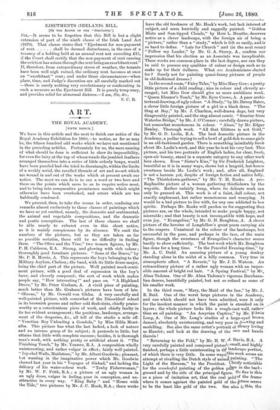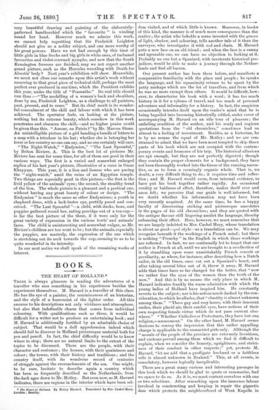ART.
THE ROYAL ACADEMY.
[FIFTH NOTICE.]
WE have in this article and the next to finish our notice of the Royal Academy Exhibition for 1880,—to notice, as far as may be, the fifteen hundred odd works which we have not mentioned in the preceding articles. Fortunately for us, the mere naming of what should be done is sufficient to show its impossibility, for even the fairy at the tap of whose wands the jumbled feathers arranged themselves into a series of little orderly heaps, would have been puzzled had she tried to disentangle, within the limits of a weekly serial, the ravelled threads of art and no-art which are wound in and out of the works which at present await our notice. The most we can do is to say a word or two here and there on the points which seem to us to require notice most, and to bring into comparative prominence merits which might otherwise have been overlooked, and errors which are too habitually condoned.
We proceed, then, to take the rooms in order, confining our remarks almost exclusively to those classes of paintings which we have as yet omitted, namely, the domestic and sentimental, the animal and vegetable compositions, and the dramatic and poetic conceptions. The last of these classes we shall be able nearly to exhaust even in this short notice, as it is mainly conspicuous by its absence. We omit the numbers of the pictures, but as they are taken as far as possible seriatim, there will be no difficulty in finding them. "The Olive and the Vine," two women figures, by Mr. P. H. Calderon, R.A. Strong, and glowing with rich colour ; thoroughly good furniture pictures. " Sons of the Brave," by Mr. P. R. Morris, A. This represents the boys belonging to the Military Asylum, Chelsea ; the band, with its little drum-major, being the chief part of the picture. Well painted mock-senti- ment picture, with a good deal of expression in the boy's faces, and cleverly composed ; the sort of work which makes people say, " How interesting !" and pass on. "A Highland Drove," by Mr. Peter Graham, A. A vivid piece of painting, much better than Mr. Graham's pictures have been of late.
CEnone," by Mr. Oswald von Glehn. A very carefully and well-painted picture, with somewhat of the Dusseldorf school in its brownish greens and rather cold flesh-tints, chiefly praise- worthy as a conscientious piece of work, and chiefly faulty in its too evident arrangement ; the positions, landscape, arrange- ment of the draperies, &c., all tell of the studio a mile off. " Venetian Boy Unloading a Gondola," by Miss Hilda Mont- alba. This picture has what the last lacked, a look of nature and an intense grasp of its subject ; it pretends to little, but attains that little with complete success ; besides, it is thorough man's work, with nothing pretty or artificial about it. "The Finishing Touch," by Mr. Yeames, R.A. A composition wholly uninteresting, and rather vulgar in effect; fairly well'painted. " Ivy-clad Walls, Maidstone," by Mr. Albert Goodwin ; pleasant, bat wanting in the imaginative power which Mr. Goodwin showed last year in his " Voyages of Sinbad," and lacking the delicacy of his water-colour work. " Tenby Fisherwoman," by Mr. W. P. Frith, RA.; a picture of an ugly woman in an ugly dress, vulgar in feeling, poor in conception, and un- attractive in every way. " King Baby " and " Home with the Tide," two pictures by Mr. J. C. Hook, R.A.; these works
have the old freshness of Mr. Hook's work, but lack interest of subject, and seem hurriedly and raggedly painted. " Golden Mists and Sun-tipped Clouds," by Herr L. Munthe, deserves notice as a clever landscape, with the foreign air of being a "picture," rather than a " study," which is felt so easily, and is so hard to define. " Late for Church " and (in the next room) " Follow my Leader," by Mr. G. A. Storey, A., confirm our impression that his election as an Associate was inexplicable. These works are common-place in the last degree, nor can they be said to possess any qualities of colour or design such as to make up for their dullness. What are Academicians elected for P Surely not for painting quasi-funny pictures of people in old-fashioned dresses!
In the second room, "Fairy Tales," by Miss Mary Gow; a pretty little picture of a child reading ; nice in colour and cleverly ar- ranged; but Miss Gow should give us more ambitious work. " Queen Eleanor's Tomb," by Mr. Eyre Crowe, A. A poor archi- tectural drawing, of ugly colour. "A Study," by Mr. Dewey Bates,. a clever little foreign picture of a girl in a black dress. " The Stag at Bay," by Mr. J. Charlton, well-drawn dogs, but very disagreeably painted, and the stag almost comic. " Sunrise from Waterloo Bridge," by Mr. J. O'Connor ; carefully drawn picture, but somewhat monotonous in colour. " Aloes," by Mr. Edgar Hanley. Thorough work. "All that Glitters is not Gold," by Mr. G. D. Leslie, R.A. The best domestic picture in the Academy, a pedlar trying to sell a bowl of gold-fish to some girls in an old-fashioned garden. There is something inimitably fresir about Mr. Leslie's work, and this year he is at his very best. This picture, and his two portraits of English ladies, for clear, fresh., open-air beauty, stand in a separate category to any other work here shown. Even " Sister's Kiss," by Sir Frederick Leighton, beautiful as it is in many ways, shows but a languid, hot-house sweetness beside Mr. Leslie's work ; and, after all, England is not a hareem yet, despite of foreign fiction and native folly. " The Thistledown-gatherer," by Mr. T. M. Rooke. A pre- Raphaelite picture of a woman gathering thistledown by the wayside. Rather unfairly hung, where its delicate work can only be guessed at. This work is of a faint, dull colour, not exactly unpleasant, but rather monotonous and wearying. It would be a bad picture to live with, for any one addicted to low spirits. Perhaps Mr. Rooke will pardon us for suggesting that pictures are, on the whole, intended to make people happy, not miserable ; and that beauty is not incompatible with hope, and even joy. " Evangeline," by Mr. G. H. Boughton, A. A clever picture of the heroine of Longfellow's great poem carrying ale to the reapers. Unnatural in the colour of the landscape, but successful in the pose, and perhaps in the face, of the main figure, though the sweetness of Evaugeline's character seems hardly to show sufficiently. The best work which Mr. Boughton has done for a long time. "In the Peaceful Evening-time," by Mr. A. C. Dodd. An amusing picture of a young donkey standing alone in the midst of a hilly common. Very true in atmospheric effect. "A Reverie," by Mr. J. D. Watson. Au extraordinary picture of a rather ugly woman with an impos- Bible amount of bright red hair. " A Spring Festival," by Mr_ Alma Tadema. One of Mr. Alma Tadema's vigorous Bacchana- lian dances, beautifully painted, but not so refined as some of his smaller work.
In the third room, "Mary, the Maid of the Inn," by Mr. J.
R. Reid. One of the worst large pictures in the Academy, and one which should not have been admitted, were it only for the insolent manner in which the paint is streaked on in layers ; the whole picture looks like a rough-cast wall, rathcer than an oil painting. "An Assyrian Captive," by Mr. Edwin Long, A. One of Mr. Long's studies of a large-eyed brown. damsel, absolutely uninteresting, and very poor in d-owing and modelling. See also the same artist's portrait of Henry Irving as Hamlet; and look at the drawing of the race and hands therein !
" Returning to the Fold," by Mr. H. W. Davis, B.A. A very carefully painted and composed picturP, small, and highly finished, perhaps a little uninteresting in tl landscape portion, this work seems am of which there is very little. In some ways attempt at rivalling the Dutch style of anim Painting. "The in the back- ground Light of the Hareem," by the President. hiefly noticeable for the wonderful painting of the golden pil ground and by the side of the principal figure. So fine is this as a piece of imitation art, that the real gold of the frame where it comes against the painted gold of the icture seems to be the least like gold of the two See also ii this, the very beautiful drawing and painting of the elaborately- patterned handkerchief which the " favourite " is winding round her head. However such we admire this work, we cannot help regretting that Sir Frederick Leighton should not give us a nobler subject, and one more worthy of his great powers. Have we not had enough by this time of little girls in blue frocks and big girls in white ones, of turbaned 'favourites and violet-crowned nymphs, and now that the South Kensington frescoes are finished, may we not expect another grand picture, such as the Hercules wrestling with Death for Alcestis' body P Next year's exhibition will show. Meanwhile, we must not close our remarks upon this artist's work without recurring to that great piece of technical skill, perhaps the most perfect ever produced in our time, which the President exhibits this year, under the title of " Psamathe." Its real title should run thus :—" The modelling of a woman's back and shoulders, done by me, Frederick Leighton, as a challenge to all painters, past, present, and to come." But its chief merit is its wonder- ' ful concealment of the skill and labour with which it has been achieved. The spectator feels, on looking at the picture, nothing but its extreme beauty, which somehow in this work penetrates and obscures the skill,—and no higher praise could be given than this. "Amour, ou Patrie P" by Mr. Marcus Stone. An unintelligible picture of a girl handing a bundle of letters to a man with a tricolour in his hat; whether she is betraying her lover or her country no one can say, and no one certainly will care.
"The Night-Watch," " Endymion," "The Last Spoonful," by Briton Riviere, A. This is the best lot of pictures Mr. Riviere has sent for some time, for all of them are good in their various ways. The first is a varied and somewhat enlarged replica of his last year's picture, illustrative of a verse in Omar Khayyam. This year, it is a lion and lioness who are pacing the " night-watch," amid the ruins of an Egyptian temple. Two things are especially good in this picture,—the first is the livid yellow of the animals' eyes ; the second, the stealthy tread of the lion. The whole picture is a pleasant and a poetical one, without having any great beauty of colour or design. "The Endymion " is much the same as other Endymions; a youth in shepherd dress, with a lack-lustre eye, prettily posed and con- ceived. "The Last Spoonful "—a child, with ducks, hens, and puppies gathered round her, eating porridge out of a tea-cup- is far the best picture of the three, if it were only for the great variety of expression in the various fowls' and animals' faces. The child is uninteresting and somewhat vulgar, as Mr. Riviere's children are too wont to be ; but the animals, especially the puppies, are masterly, the expression of the one which is stretching out its neck towards the cup, seeming to us to be quite wonderful in its intensity.
In our next notice we shall speak of the remaining works of interest.



































 Previous page
Previous page